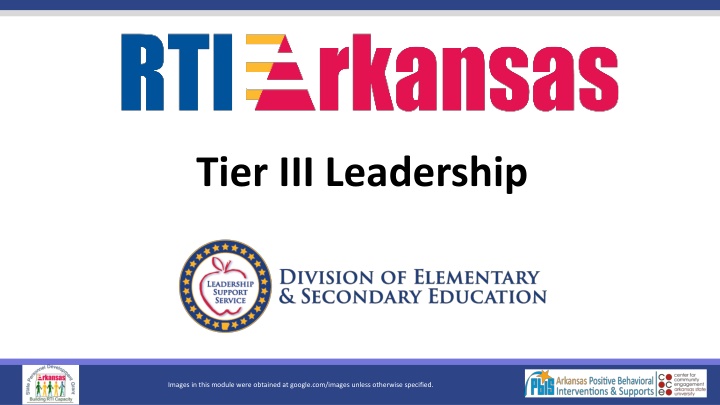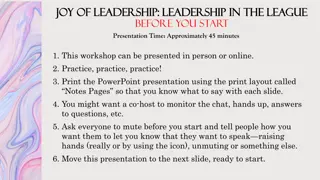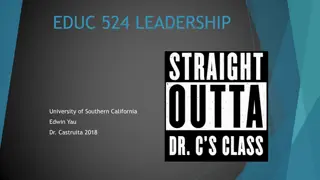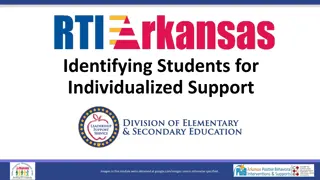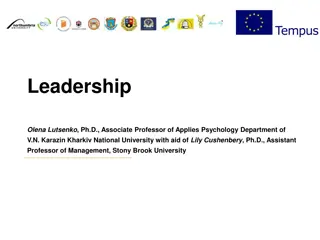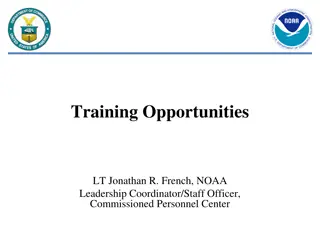Enhancing Tier III Leadership for School Development
This module focuses on providing information to schools to develop strong Tier III leadership by structuring teams and meetings effectively. Participants will learn about planning and implementing Tier III leadership, roles, responsibilities, and developing action teams for individual students. Follow a case study at University Heights Elementary to understand the process better.
Download Presentation

Please find below an Image/Link to download the presentation.
The content on the website is provided AS IS for your information and personal use only. It may not be sold, licensed, or shared on other websites without obtaining consent from the author.If you encounter any issues during the download, it is possible that the publisher has removed the file from their server.
You are allowed to download the files provided on this website for personal or commercial use, subject to the condition that they are used lawfully. All files are the property of their respective owners.
The content on the website is provided AS IS for your information and personal use only. It may not be sold, licensed, or shared on other websites without obtaining consent from the author.
E N D
Presentation Transcript
Tier III Leadership Images in this module were obtained at google.com/images unless otherwise specified.
Purpose of This Module Provide information that will help schools develop strong Tier III leadership through structuring their teams and team meetings
Participants will learn about How to plan for implementing Tier III Leadership at Tier III Core (systems) and action teams Learn the roles and responsibilities of the core (systems) leadership team Learn how to develop action teams for individual students Objectives
The Tiered Fidelity Inventory (TFI) Tier III Planning Tool TEAM 3.1 Team Composition 3.2 Team Operating Procedures 3.3 Screening 3.4 Student Support Team SUPPORT PLANS 3.8 Quality of Life Indicators 3.9 Academic, Social, and Physical Indicators 3.10 Hypothesis Statement 3.11 Comprehensive Support 3.12 Natural and Formal Supports 3.13 Access to Tier I and Tier II Support RESOURCES 3.5 Staffing 3.6 Student/Family/Community Involvement 3.7 Professional Development EVALUATION 3.14 Data System 3.15 Data-Based Decision Making 3.16 Level of Use 3.17 Annual Evaluation
In each of the Tier III modules, we are going to follow a Case Study to illustrate the process of Tier III. In this module, the Case Study will focus on the process a school took to create their Core Team and an Action Team for a particular student who had been referred for Tier III services. Introduction to the Case Study
University Heights Elementary University Heights Elementary School has 500 students in grades 1-4. They are in the early stages of Tier III implementation. They have a Core Team assembled for Tier III and have acquired the necessary training for those involved. The Core Team is ready to begin meeting to fulfill their initial and ongoing team responsibilities.
Follow Aidens Journey 7 year old, 2nd grader at University Heights Behaviors: throwing classroom materials, cussing at teacher, shouting at peers Referred for Tier II interventions Received Big Buddy social skills mentoring three days/week for six weeks, with negative results Because of negative response and intensifying of behaviors, being referred for Tier III interventions
Planning for Tier III What practices are currently in place to support individual students? How many students do you expect to be supporting at Tier III? What are your goals for Tier III?
Planning for Intervention: School Profile At University Heights Elementary School, the student population is 500 students. If Tier I universal practices are implemented with fidelity, it is expected that 80%, or 400 students, will use the expected behaviors without additional support. Approximately 10-15%, or 50-75 students, may need a little extra support (Tier II), and 1-5%, or 5-25 students may require intensive levels of support (Tier III), during the school year.
Tracking Access to Tier III Schools need a written process for tracking the proportion of students participating in Tier III supports. Should monitor whether all students needing Tier III supports have access to those supports Should monitor the proportion of students who have Tier III plans in place (should fall between 1-5% of student population)
Leadership at Tier III Tier III systems, data, and practices are led by a core team. This intensive system must include the following: Personnel who are trained in the basic principles of behavior, functional assessment, and behavior support planning Personnel with administrative authority A system for early identification and referral An organizational structure that allows for flexible teaming and planning
Team-based Processes In a review of FBA studies, Goh and Bambara (2012) found that out of all variables they analyzed, teaming had the most significant effect on the success of the FBA implementation. Deanne Crone, Leanne Hawkin, & Rob Horner, 2015
Teaming Is Critical in Tier III Content specialists Representative school-based teams School-based teams that include content specialists Benazzi, Horner, & Good, 2006
Education Experts Child/Teen Experts Intervention Experts Implement Tier III strategies Inform & support Tier III Collaborate to develop Tier III Enhance communication with school to support Tier II Support education and child experts in Tier II Enhance communication with home to support Tier II Differentiate Tier I (classroom instruction and intervention) Support Tier I (classroom instruction and intervention) Support Tier I (classroom instruction and intervention)
Resources Needed Team members working with individual students will need time for the following: Attending trainings to develop expertise Conducting the FBA Developing, implementing, and monitoring the resulting BIP
Schedule Regular Meetings Tier III teams need to meet regularly to have systems discussions, review data, and action plan.
Action Planning Provides a framework for assessing how to complete a task effectively. Process typically contains these elements: Goals Measures of success Activities/steps Timelines Resources Person(s) responsible
Goals and Measuring Success Establish goals by asking, What things do we need to do to move our work forward? Measure your success by asking, What completed products, data or processes are in place after the work is finished?
Activities and Steps After identifying the goal and what success looks like, list ideas in a rational sequence needed to achieve the goal, for example: What is the first action that needs to take place? What happens next? Any activities that are prioritized to meet deadlines?
Timelines and Resources Partner the timeline with outlined activities and steps. What can realistically be done in a specified amount of time? What assistance or resources will be needed to complete the tasks?
Persons Responsible and Deadlines The team delegates a person to complete each task. The action plan includes dates when activities should and have been completed.
Teaming at PBIS Tier III Core Team (systems) Conversations: Monitor effectiveness of complex FBA/BIP and wraparound supports. Review aggregate Tier III data to make decisions about any improvements needed for the interventions themselves. Action Team (problem solving) examples: FBA/BIP team developed for each student Wraparound team for each student
Core (Systems) Teams
Initial Core Team Responsibilities Develop standardized processes: Identifying students for Tier III support Conducting FBAs Developing and monitoring BIPs Identifying and prompting participation of action team members, including family members and student (if applicable) Updating team, staff, and others involved with student supports Create a model for offering staff professional development and training.
Annual Evaluation At least once a year, the Tier III Core Team will conduct a fidelity assessment (e.g., TFI). This annual assessment will be used for action planning.
Core Team Membership Administrator (or someone with administrative authority) Member with behavioral expertise Member with academic expertise Crossover member (if there are separate Tier II and III core teams)
Core Member Roles Four team roles are needed as the Tier III systems are developed: Facilitator- prepares agenda, facilitates meeting, follows-up on assigned tasks Recorder- takes notes (including decisions, assigned tasks, and deadlines set during the meeting) and distributes this information to all stakeholders Administrator- supports process with attendance, restructures resources as needed, and shares updates with staff Crossover Member - provides direct line of communication between Tier II and Tier III teams (can be a member listed above or a fourth member)
Brainstorm who at your school might have the expertise needed for your Tier III core team: Administrative Authority Behavioral Expertise Academic Expertise Tier II Expertise Table Talk
Scheduling Considerations It is essential that the core team has a scheduled meeting time and an effective meeting format. Administration provides release time for core team members; for example: Paraprofessionals/aides covering classes Staff members with unassigned duties covering a class Utilizing specialists (art, P.E., music, media) for coverage Flex time before/after school for team members
Core (Systems) Team Meeting Format The next slide contains a sample agenda template that can be used for systems-level discussions at Tier II or Tier III. The four slides following the agenda contain a sample agenda template that can be used for problem-solving discussions at Tier II or Tier III.
Sample Agenda For Systems Conversation
Problem Solving Meeting Agenda (Page 1)
Agenda (Page 2)
Agenda (Page 3)
Agenda (Page 4)
Developing Action Teams Once the Tier III process is established, the core team s focus shifts: Receive referrals for students to receive Tier III support Determine whether referred students meet the criteria for Tier III interventions Contact action team members and assign tasks
Supporting Action Teams Core Team member(s) support the Action Team initially. Provide professional development Support in completing functional behavior assessment Support in creating a behavior intervention plan Core Team member(s) will fade support and the Action Teams will begin functioning independently.
Examples of Action Teams Wraparound team The family of the child invites all relevant stakeholders. Wraparound facilitators engage families to ensure that the team is created by and for the family. Relevant school staff are also invited to participate. Individual youth FBA/BIP team Uniquely created for each individual child. Families are critical members of the team. All relevant individuals and staff are invited.
Who should be a member of the action team (based on each student)? How will release time be provided to attend weekly action team meetings? Who will be responsible for contacting potential action team members? How will the potential action team members be contacted? Guiding Questions for Developing Action Teams
Core Team In order to have all the expertise required on a Tier III Core Team, the following people were asked to join: Mr. Criswell, the Assistant Principal (Administrative Authority) Ms. Jackson, the Guidance Counselor (Behavioral Expertise) Mr. Poole, a Special Education Teacher (Academic and Behavioral Expertise) Mrs. Liddell, a Regular Education Teacher (Academic Expertise) Mr. Robinson, the Tier II Coach (Tier II Expertise)
Core Team Initial Responsibilities Ms. Jackson volunteers to be the Core Team s Facilitator. The team decides to meet every Tuesday at 3:30 in Mr. Poole s room. Ms. Jackson creates the agenda and sends it out ahead of time. During their first few meetings, the team creates a standardized referral process for identifying students for Tier III interventions. This process includes the forms that will be used, the data decision rules that they will use to determine whether students qualify for Tier III interventions, and what training will be needed for faculty, staff, and parents regarding this process.
Core Team Initial Responsibilities (cont.) The team creates a standardized process for conducting Functional Behavior Assessments and writing Behavior Intervention Plans. Because Mr. Poole has some experience with these processes, the team decides he will train the action teams. The team also creates a written process for providing ongoing Professional Development around Tier III.
Core Team Ongoing Responsibilities After Tier III implementation is underway and all processes have been put into place, the Tier III Core Team begins to receive referrals for individual students to receive Tier III interventions. The Core Team reviews each referral to see if each student meets the previously established criteria for Tier III interventions. When a student meets the criteria, the Core Team delegates one of its members to create an Action (Problem-Solving) Team for that student.
Core Team Reviews a Referral Mr. Jones, the 2nd grade teacher, refers 7-year-old Aiden for Tier III interventions based on the following behaviors: throwing classroom materials, cussing at teacher, and shouting at peers. Aiden has been receiving Tier II Social Skills interventions (Big Buddy Mentoring) for the past 6 weeks. His behavior, which began in the classroom, has intensified and spread to the cafeteria, school bus, and at home. After reviewing the data, the Core Team decides to put together an Action Team to conduct an FBA to determine if a Behavior Intervention Plan or other services are needed for Aiden.
Action Team Created Mr. Criswell volunteers to put together an Action Team for Aiden. He asks the following people to serve as Aiden s Action Team based on their knowledge of Aiden: Mr. Jones, Aiden s teacher Mrs. Kelly, the school nurse who has good rapport with Aiden Linda Hendricks, Aiden s mother Ms. Jackson, the Guidance Counselor. She will guide the team in the FBA/BIP process The Action Team decides to meet on Wednesdays at 8:15 a.m. A sub is provided for Mr. Jones.
